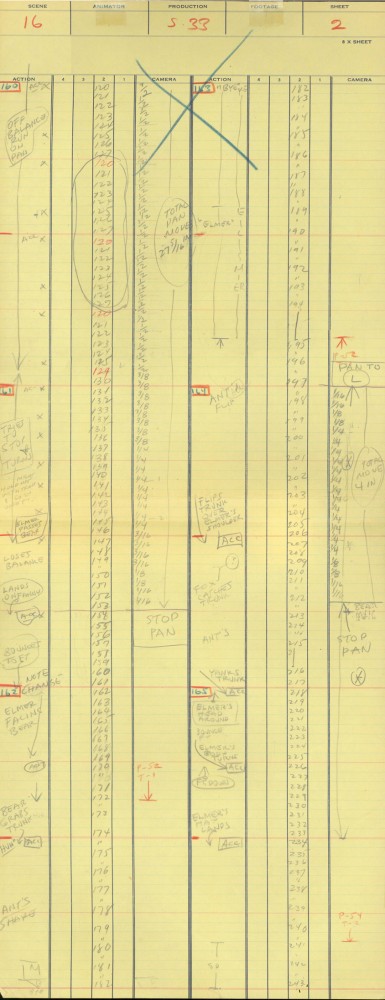Animation Artifacts &Commentary &Disney 05 Mar 2009 09:07 am
Elmer Elephant
- The post on exposure sheets drew a lot of attention, which is something that pleased me. Perhaps there’s enough interest in the heart of the medium to keep it alive.

Robert Cowan sent me an exposure sheet that was tucked into an envelope in the Ingeborg Willy Scrapbook, which he owns. (Ingeborg Willy was an inker working at Disney’s during the 30′s and made a photographic scrapbook of her stay.)
The sheet is from the Silly Symphony, Elmer Elephant (1935).

(Click any image to enlarge.)
The film’s about a bunch of baby animals.
Elmer is the shy kid who gets laughed at by the other kids.

Eventually with the help of an old giraffe he saves the day by putting out a fire …
This exposure sheet is about a sequence wherein Elmer is pushed across a row of animals and is poked and prodded in absolute humiliation.
Let’s review what’s on the sheet for the completely unitiated viewer:
There are several columns: Action, 4,3,2,1 and camera.
These are basic to all X-sheets. Sometimes you get 5 numerals, oftentimes you get a column for Bg. Uusaly there’s also a Track column.
Below these descriptives you have lines. Each light blue line represents one frame of film. If the drawing’s on twos or threes or more it’s indicated as in #149. Other numbers are on ones – one frame per drawing.
In the “Action” column, the director writes notes telling where he wants some action to happen. For example: the director has noted that he wants Elmer to try to stop his turn from frames 32 through 49. The animator will follow this as best as possible.
The numbered columns represent cel levels. #1 is the bottom cel and #4 is the top cel. Most sheets also have a column for the Background so you know what number Bg is called for.
The “Camera” column indicates any special camera movements or effects. There we see a pan. The Bg is moving from screen right to left. The actual amount of the physical movement is indicated on every frame. 1/2 is a half inch, 1/4 is a quarter inch etc. Pans usually slow down as they come to a stop and gear up when they start out. This is why it goes from 1/2 to 3/8 to 1/4 to 3/16 to 1/8 to 1/16 before you reach STOP PAN.
You’ll see the sound track indicated at red marked 163 top line middle of the sheet. A character is saying, “Bye Elmer.” The actual number of frames it takes is broken down for you. The animator would animate the mouth accordingly.
Here are frame grabs for the part exposed.
 1
1  2
2
Let’s analyze the exposure sheet a bit. (For those not familiar with X-sheets, I have more of a breakdown below.)
First off, for me it’s an oddity. There seem to be two sheets combined onto the one. It’s split down the middle into two full sheets – all using only one cel level.
Secondly, there are some highlighted numbers – 160 through 165.
These fall at every 32nd frame. I’m not sure why. It’s not a foot (16 frames) or a second (24 frames). Is it a beat? I notice that the action calls for “ACC” at each of these markings. I assume it stands for “Accent” which would make that part of a musical tempo. Every 16th frame is also marked in red. This would be the only indication that this is what it is.
The pan moves are indicate in FRACTIONS ! I’m not sure why since it created a difficult transposition to decimals for the camera operator. I mean 3/8 of an inch equals what? Quickly now. Time is money. How about 1/16th? I have only met fractions which divided into 20ths. When did the change come in? John Oxberry, anyone?
Of course, some master checker would probably do the math before the scene got to camera.
Some of the drawings are exposed on twos, even for a short bit during the pan. This would be anathema in modern day animation, yet it hasn’t gotten better.
The track reading isn’t the most detailed I’ve seen, yet it does the job, doesn’t it?
The film is directed by Wilfred Jackson. I assume the “Action” column was filled out by him. I think the animation was by Paul Hopkins.
There’s a lot of information that can be pulled out from this one exposure sheet of a film done 73 years ago. Is that enough reason to advocate for continued use of the Exposure Seet?










on 05 Mar 2009 at 10:38 am 1.Robert Cowan said …
Michael – Thanks for your work on this piece. Finding the images to match the sheet is a huge help… -Bob
on 05 Mar 2009 at 5:15 pm 2.Hans Perk said …
Thanks for this sheet, Bob and all your work, Michael!
Actually, this sheet is the NEARLY the same form as the one I mentioned in your last x-sheet post, I see, which is not strange, as the production number is one apart!
The difference is most telling, though: your sheet is called an “8-X SHEET”, and has lines every 8 frames, while the one I posted is called “12-X SHEET,” which has markings for every 12 frames and double lines marking each foot.
In Lee Payne’s tech manuals, which I posted here, you can see that indication in fractions was standard. The camera department would figure out the relation to the numerical counters on the camera stands.
Later, I do not know when but it seems it could be in the 40′s, animators and/or assistants were given a little booklet with camera moves, with ease-ins and ease-outs in 8 and 16 frames, moves all counted in 1/100′s (.01, .02 etc), though based on a constant speed given in fractions(!) This was based on the center peg being centered in 5000, in other words, they had to know more about the numbers, something that still was exactly the same in the early 90s when we worked for Don Bluth.
on 05 Mar 2009 at 5:19 pm 3.Fabián Fucci said …
No wonder. Very complex pan moves were sent to professional calculators (men, not machines) before being performed at the camera (this according to the book by Halas & Batchelor).
on 05 Mar 2009 at 8:35 pm 4.Mark Sonntag said …
I think the current discussion on x-sheets is important, especially as there is a huge over reliance on graph editors. Personally, I still use x-sheets even when working out animatics. There is a level of control one has when planning scenes this way, not to mention hones timing skills. Excellent work.
on 05 Mar 2009 at 11:45 pm 5.Alexander Rannie said …
I received this informed email, and thought I’d include it among the comments since it’s elucidating (M.S.):
The highlighted numbers on the Elmer X-sheet, 160 through 165, indicate bars of music. And I believe your surmise about “ACC” indicating an accent is correct.
The tempo for this scene is 2-16′s, with each bar of music consisting of two beats, each beat being 16 frames in length (or 90 beats per minute, if you’re using a metronome).
Thanks, as always, for an engaging and smart blog!
on 06 Mar 2009 at 7:25 am 6.slowtiger said …
In a pen-on-paper environment, the X-sheet is a must. You’ve shown some of the most luxurious specimen: printed in different colours! 1990 in Berlin we had nth-generation xeroxed copies on standard A3 sheets. This created very heavy black lines, “optical clutter” (E. Tufte) which made it hard to read the pencilled numbers. If I remember correctly, they had the 24/8 lines pattern and 96 lines per sheet. This was the same for X-sheets from all european studios I saw. (If I can find one, I’ll scan it in.)
However, I’m still waiting for a really good implementation of X-sheets (and charts) in digital animation. One should expect this wouldn’t be much of a problem since all frames are internally stored in lists already. But, aside from some minor issues, like no compatibility between programs, there’s one major point not yet addressed by developers, and that is the dual funtion of an X-sheet being the record of an animator’s work as well as the documentation of a director’s intentions.
And there’s a new generation of animators who don’t even know about the concept at all. I already met some who were totally lost when they learned they couldn’t edit the “tweening curves” graphically. It didn’t even occured to them to just create more keyframe poses.
on 06 Mar 2009 at 10:09 am 7.Stephen Perry said …
The use of 2′s on a pan was a common practice at Disney’s when the feet were either not in contact with the bg for a period, or out of shot. So having the character on 2′s while panning the bg on 1′s is not that noticeable as long as the feet don’t make contact with the ground. I’m sure that on the bottom of the bg the pan moves per frame would have been marked in inches, so there would have been no need to convert them into fractions for the counters on the camera…
on 06 Mar 2009 at 9:11 pm 8.Charles Brubaker said …
As someone who’s about to study animation I found this helpful. Thanks for helping me read this thing.
So animators have to be a good engineer in addition of being able to draw. Who would’ve thought?